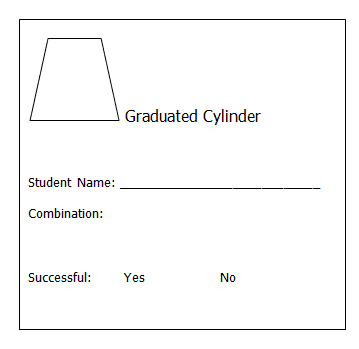Lesson Plan Title : How Full Can You Go?
Age Range:
Grade 6 through Grade 8 (Middle School)
Overview and Purpose:
This lesson is a fun way to introduce students to graduated cylinders. They will be able experiment and try to judge the volume by the shape of the cylinder. Some may find it is not easy to figure out how much room is left in the narrow neck or wide bottom.
Objective:
The student will be able to fill a graduated cylinder to the top without it overflowing using three different measuring cups and/or spoons. We are looking for basic measurement skills to be obtained here. Hopefully a good bit of luck too.
Resources:
Various sizes and shapes of graduated cylinders with the measurements removed
Shallow pans
Tablespoons
1/4 measuring cups
1/2 measuring cups
Bowls of water
Science journal or teacher created worksheet
Activities:
Divide the class into groups of three. Students should put the cylinders in a shallow pan one at a time. They can then take turns seeing who can fill each one to the top (without them overflowing) with the fewest cups and/or spoonfuls of water. They have to fill the measuring cups and spoons to the top and pour all of the water into the cylinder for their turn to count. Students should take turns going first, since they will learn from watching the others. Have them record their results on their worksheets or in their journals.
Come back together and compare results. Have the students try to figure out the combination the groups used who had the fewest numbers listed for each cylinder. Come back a second time and have the groups give the combination of cups and spoonfuls.
Sample chart for a worksheet:

Closure:
Judging the volume of a graduated cylinder can be difficult for tactile learners. This lesson gives all types of learners an opportunity to experiment and handle the cylinders. Extend this activity by talking about the different ways students planned which measuring cups and spoons to use.